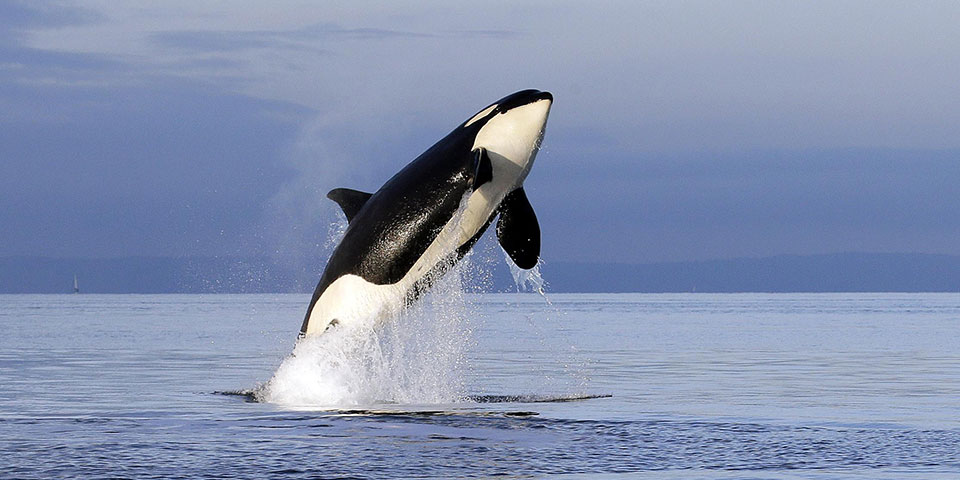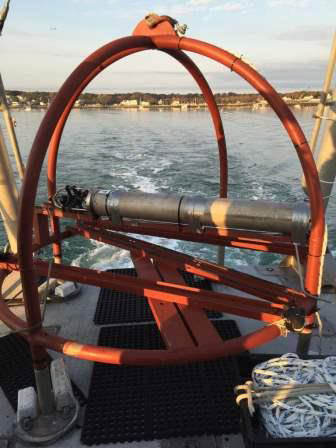Noise
Olympic Coast

Why is it a concern?
With the growth in vessel traffic during the last 50 years, the level of ocean noise pollution has also increased. Commercial shipping traffic, fishing vessels, research ships and military activities all contribute to degradation of the natural ocean soundscape. Olympic Coast National Marine Sanctuary lies at the western entrance to the Strait of Juan de Fuca, a marine transit route for large vessels heading to and from busy commercial ports in Puget Sound and Vancouver, Canada.
Although acoustic impacts to wildlife in Olympic Coast National Marine Sanctuary have not been documented directly, underwater noise pollution in other locations has been linked to disturbance and injury in marine mammals and other wildlife. Marine mammals respond behaviorally to noise by altering the direction of travel, depth or speed of their dives, extending their dive durations, shielding their young, changing vocalization patterns, and leaving the affected area, which could be an important feeding area. Acute sound intensities can cause temporary or permanent hearing loss in marine mammals and other wildlife. Disorientation or compromised hearing may account for some cases in which ships collide with marine mammals that are unaware of an approaching vessel. Chronic low frequency noise tends to be long-term and broad in scale and impacts a broad group of acoustically sensitive species including invertebrates, fish, and marine mammals. Important ecological processes including predator prey interactions, growth and reproduction, recruitment, and detection of mates may be negatively affected by increased chronic noise.
Ocean noise pollution is an emerging management concern, yet there is no baseline or historical record of the ambient environment. In 2014, a NOAA Noise Reference Station Network buoy (NRS03) was deployed as a long-term installation to characterize the ocean ambient sound field, or noise levels in deep waters off the Washington Coast. Additional ongoing acoustic research in or near OCNMS includes multiple buoys installed to collect marine mammal vocalizations for identification of species and area use, including buoys to document winter use of the outer coast by endangered Southern Resident killer whales.
Overview of Research
Olympic Coast National Marine Sanctuary is actively seeking research partners to conduct work connected to noise as a sentinel issue.
| Project Name | PI and contacts | Links |
|---|---|---|
Marine mammal demographics off the outer Washington coast |
John Hildebrand, SCRIPPS |
|
NOAA Noise Reference Station Network (NRS) |
Leila Hatch, Holger Klinck, Oregon State University |
http://bioacoustics.oregonstate.edu/project/noaa-ocean-noise-reference-station-network http://www.pmel.noaa.gov/acoustics/ocean-noise-reference.html |
Critical Habitat for Southern Resident Killer Whales |
Brad Hanson, NMFS |

Science Needs and Questions
The best available science is used by sanctuary scientists and managers working to address priority resource conservation and management issues. As priorities change and new issues emerge, each sanctuary develops new science needs and questions and works with partners to address them.
- What are the relative inputs of sound from various sources to the sanctuary’s total “ocean noise budgets,” and how do they vary at temporal and spatial scales?
- What are the spatial and temporal patterns of noise produced by various types of vessels within the sanctuary?
- How are anthropogenic sounds affected by topography or ocean conditions?
- Are changes in the behaviors of vocally active marine animals relative to anthropogenic sound sources biologically significant?
- Do vessel traffic and cetacean distribution patterns overlap in time and space to create enhanced risk of ship strikes?
Education and Outreach Material
Podcast on Noise and Soundscapes in National Marine Sanctuaries with Dr. Leila Hatch
Blinded by the Noise – Whales and Dolphins in a Noisy Ocean
Discovery of Sound in the Sea offers many resources related to the issue of noise in the ocean.
References
Cummins, Amanda J., et al. 2011. Passive acoustic and visual monitoring of humpback whales (Megaptera novaeangliae) in the Olympic Coast National Marine Sanctuary: Importance of quantifying call type. The Journal of the Acoustical Society of America 130.4: 2422-2422.
Hildebrand, John A. "Anthropogenic and natural sources of ambient noise in the ocean." Marine Ecology Progress Series 395.5 (2009).
Oleson, Erin, and John Hildebrand. Marine mammal demographics off the outer Washington coast and near Hawaii. No. NPS-OC-12-001CR. OFFICE OF THE CHIEF OF NAVAL OPERATIONS WASHINGTON DC, 2012.
Douglas, Annie B. et al. 2008. Incidence of ship strikes of large whales in Washington State. Journal of the Marine Biological Association of the United Kingdom: 88:1-12.

